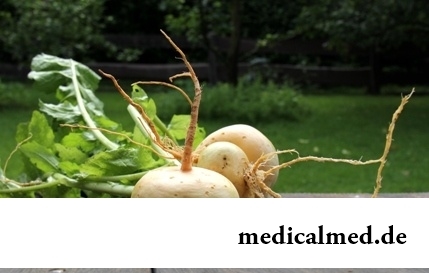





Rice vinegar
For the last decade rice vinegar gained wide popularity in the international kitchen. Today this the type of vinegar, most widespread in Asia, everything to a bowl is used in preparation of dishes of European cuisine.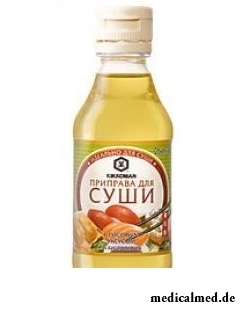
Description
The term "sou" in Japan means "acetic rice". There was this product in China more than two thousand years ago. In Japan it appeared approximately in 4-3 century B.C. There rice vinegar cost fabulously much therefore enjoyed popularity only at exclusive sectors of society. In kitchens of the simple people it appeared approximately in the 16th century.
At first "sous" used as seasoning to rice. Over time use of rice vinegar extended and its began to use in the course of preparation of the Japanese national dish – sushi. Initially for making sushi cut small pieces of crude fish, salted them and mixed with rice. Through certain time fish emitted enzymes under the influence of which rice produced lactic acid. That, in turn, promoted process of preservation of the pressed fish. Similar natural "marinade" not only gave to a dish special soft and slightly sourish smack, but also allowed it not to spoil a long time. Such process of sour-milk fermentation took a long time – from two months to one year. Therefore in the 17th century there was a new compounding of making sushi which was based on use of rice vinegar. Thanks to this product duration of making sushi not only it was considerably reduced, but also tastes were significantly enriched.
Preparation of rice vinegar
As a rule, rice vinegar is done of rice wine or the overfermented rice.
Today there are three kinds of "sou": white, black and red.
Mix from sticky and dlinnozernovy rice grades to which add barley, wheat and a rice peel is the cornerstone of black "sou". This mix undergoes double fermentation then it is drawn by seven months. At the exit vinegar of dark color, dense and with saturated taste which, depending on preferences of the producer, varies from sweet to stronger turns out.
Preparation of rice vinegar red happens by fermentation of red barmy rice, that is, the rice which is previously processed by red yeast. Its aroma and taste differs in fruit and tart and sweet shades.
White vinegar is received from sticky rice, and it has the softest taste. On the subtlety and tenderness white rice vinegar bypassed even the known French wine white vinegar.
By the way, despite complexity of preparation of rice vinegar, it can quite be made in house conditions. The main condition – to use qualitative rice. For preparation it is necessary to wash out 300 grams of rice in cold water, to place in ceramic or glasswares and to fill in with 1,2 liters of water. Approximately for 4-5 hours to put ware to the warm place, and later for several days to move to the cold place. Several days later rice to filter, and to add 900 g of sugar to the received liquid, it is good to mix before its full dissolution and to put solution on a steam bath for half an hour. To remove from fire and to allow to cool down then to pour it in a 2-liter jar and to add there a third of a tablespoon of yeast. To leave vinegar to wander for a week then to pour it in wine ware, to cover from above with a gauze and to leave "to reach" a month more. Before the use the received rice vinegar can be filtered and poured once again on small tanks.
Use of rice vinegar
"SU" is ideal as seasoning. It is often applied to pickling of various seafood, it is a part of many sauces. They can perfectly fill salads and various foods from fish and meat.
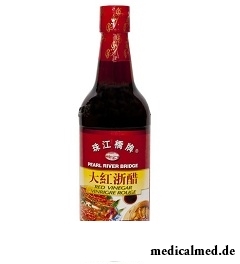 In general, use of rice vinegar depends on its look. Black "sou", for example, is ideal for the use together with meat and preparations of stewed dishes. Often season with red "sou" soups, noodles and seafood dishes, and white vinegar is suitable for preparation of sashimi and sushi, for pickling of fish and is irreplaceable ingredient of seasoning of east salad sunomono. Also by means of white "sou" prepare hot fan for frying of seafood.
In general, use of rice vinegar depends on its look. Black "sou", for example, is ideal for the use together with meat and preparations of stewed dishes. Often season with red "sou" soups, noodles and seafood dishes, and white vinegar is suitable for preparation of sashimi and sushi, for pickling of fish and is irreplaceable ingredient of seasoning of east salad sunomono. Also by means of white "sou" prepare hot fan for frying of seafood.
Structure and advantage of rice vinegar
Use of rice vinegar is not limited only to cookery. It is used also in the medical purposes. By the Japanese scientists it was revealed that a number of amino acids, important for an organism, – a histidine, a leucine, valine, a lysine, phenylalanine, an isoleucine and алгинин is a part of "sou".
Besides, as well as any product of barmy fermentation, in "sou" contains minerals and vitamins, in particular calcium, phosphorus and potassium. This gas station enjoying in the east wide popularity promotes improvement of digestion and blagotvoritelno affects functioning of cardiovascular system.
Contraindications
Today the market dazzles with various artificial products and fakes therefore upon purchase of rice vinegar it is necessary to be careful. You should not neglect careful studying of packaging and to attentively read of what components the product is made. Substitute rice vinegar contains a large amount of chemical additives, harmful to an organism.
Besides, the people having gastritis, a diabetes mellitus, obesity, a hypertension and diseases of kidneys should not be fond of rice vinegar.
In our intestines are born, millions of bacteria live and die. They can be seen only at strong increase, but if they gathered, then would be located in a usual coffee cup.

Many parents of children at the age of 2-4 years face excessively whimsical behavior of the child. The kid exhausts constant crying...
Section: Slideshow
The majority of gynecologic diseases prove three main signs, each of which speaks about need of a visit to the gynecologist. Certainly, it is possible to establish the exact diagnosis only after inspection, but on the basis of some signs it is possible пр...
Section: Articles about health
Tuberculosis – a serious infectious disease which development is caused by mycobacteria (Koch's bacilli). The illness is known from an extreme antiquity. Long time fight against it was considered as ineffective. Quite often the disease affected the whole families, and mortality from it was very high. It became the reason of emergence of a set of delusions concerning transmissibility and a possibility of treatment of tuberculosis....
Section: Articles about health
Color of plants is caused by presence at them of certain chemical compounds. Let's talk that various colors mean vegetable...
Section: Articles about health
With age in a human body harmful substances collect. We receive them with food and water, at inhalation of the contaminated air, reception of medicines, use of household chemicals and cosmetics. A considerable part of toxins accumulates in a liver, osnovno...
Section: Articles about health
Cystitis, or inflammation of a mucous membrane of a bladder, this very widespread disease which, owing to some features of a structure of bodies of urinogenital system, women have approximately four times more often than men. Women aged from 20 up to 45 years enter into the main risk group. Cystitis is an illness of a bacterial origin. It can have an acute or chronic current. The second option is dangerous not only a frequent recurrence, серьезн...
Section: Articles about health
Aging — natural and inevitable process. Over time our skin loses elasticity, on it saggings, a face form теря are formed...
Section: Articles about health
Separate food - the system of meal based on digestion physiology which is carried to improvement methods. According to nutritionists, the separate use of the carbohydrate and proteinaceous products demanding different conditions of assimilation helps to get rid from Bol...
Section: Articles about health
The name of this disease precisely reflects the problem reason: it consists in the bra fastener pressure upon a certain zone of a back. At the same time one of vertebrae of chest department of a backbone is as if blocked and loses mobility, and the loading falling on it is distributed on the next vertebrae. At 70-80% of women local pains in a backbone point on which the fastener of the often put most on bra presses result....
Section: Articles about health
It is pleasant to state a possibility of improvement of quality of life of people with problems of functioning of secretory system. By efforts that...
Section: Articles about health
All got used long ago that, having addressed the plastic surgeon, it is possible to modify natural parameters of a figure or to minimize the damages put to appearance with ruthless time. Many people (preferential women) worldwide е...
Section: Articles about health
Dietary supplements (dietary supplements) for the last decades were so thoroughly included into our life that, apparently, it is already impossible to find the person who at least once did not try them. At the same time, most of our compatriots have a vague idea of what dietary supplements as they affect a human body consist of and what differ from the real medicines in. Let's try to understand these questions, and at the same time and to understand, such additives are how necessary for us....
Section: Articles about health
The kid who was recently born is surrounded with love of adult family members and their cares without which the baby cannot exist....
Section: Articles about health
For the last decades the diabetes mellitus of the second type became really world problem. The number of cases annually increases, and average age of patients for whom the illness is diagnosed, steadily decreases. Specialists consider that one of osno...
Section: Articles about health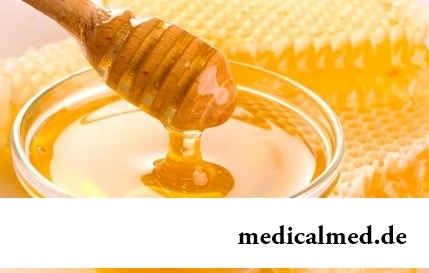
About 20% of the population of our planet have a hypertension (permanent increase in arterial pressure). This disease has an adverse effect on the standard of living, reduces working capacity, and in the absence of systematic treatment threatens with such complications as a myocardial infarction, a stroke and other heavy illnesses which can result in disability or sudden death. Most of patients for maintenance of pressure at more or less acceptable level accept appointed doctors лекарст...
Section: Articles about health
Traveling all over the world, many try to try the most exotic dishes of national cuisines. Exists even so-called died away...
Section: Articles about health
For the city dweller the fitness is the most convenient sport. It is enough to acquire the subscription to the gym to get access to various apparatuses and an opportunity to train under the leadership of the experienced consultant. Many consider fitness on...
Section: Articles about health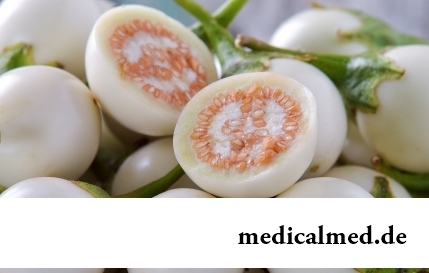
It is possible to find the extensive range of fruit and vegetables in modern shops. Russians already got used that on counters there is not only a seasonal domestic production, but the vegetables and fruit which are grown up in the countries with more comfortable conditions of cultivation at all seasons of the year. However what we see in shops and in the vegetable markets, is only a small part of those edible plants with which the nature is so rich. Today we want to acquaint the reader with rare and very useful vegetables which on...
Section: Articles about health
The mankind knows that some toxins at intake in the minimum quantities have therapeutic effect...
Section: Articles about health
Eyes – unique body on the structure thanks to which the person obtains about 80% of information on the world around: about a form, color, size, the movement, and also many other parameters of objects or phenomena. But whether much we know about the most valuable body...
Section: Articles about health
Vitamin complexes belong to the most popular drugs, probably, in our country there is no person who was not hearing about advantage of vitamins and never their accepting. The more vitamins, the better, we consider and as it appeared, cruelly we are mistaken. Whether vitamins, whether so harmlessly general hobby for polyvitaminic complexes and whether it is possible to do without them are so useful? Let's try to understand....
Section: Articles about health
Childbirth is the most important event in life of each woman. We are women we give birth to the new little man on this light. Now...
Section: Articles about health
What is in our understanding weeds? It plants which are considered to be suitable only for compost pits and feeding of animals. Meanwhile, among the weeds growing literally under legs it is possible to find the mass of the officinal herbs possessing invaluable Paul...
Section: Articles about health
According to World Health Organization, every third inhabitant of Earth has excess weight, and every tenth has obesity. The reason of this phenomenon, according to specialists, roots in one not very comforting fact: most of people consume much more calories, than it is necessary. How it turns out what we overeat? Why it is so difficult to refuse an excess portion tasty or additives? Let's try to find out what factors prevent us to eat food with reasonable moderation....
Section: Articles about health
Musicotherapy – a treatment method which caused and causes a set of a controversy concerning its efficiency. However the facts are relentless:...
Section: Articles about health
Not everyone can brag of the shining Hollywood smile. Even the person who is regularly visiting the stomatologist and watching of oral cavities over health periodically has problems: enamel of teeth darkens under the influence of some products, on it I accumulate...
Section: Articles about health
Each woman has preferences in the field of use of those goods which help us to look good, feel young and effective. Besides: selection process of favourite perfume, shampoo or decorative cosmetics already lightens the mood and serves as a peculiar stress medicine. Happens very offensively when the acquired perfumery and cosmetic products not only do not meet our expectations, but also becomes the reason of problems with health. Sources неприятн...
Section: Articles about health
